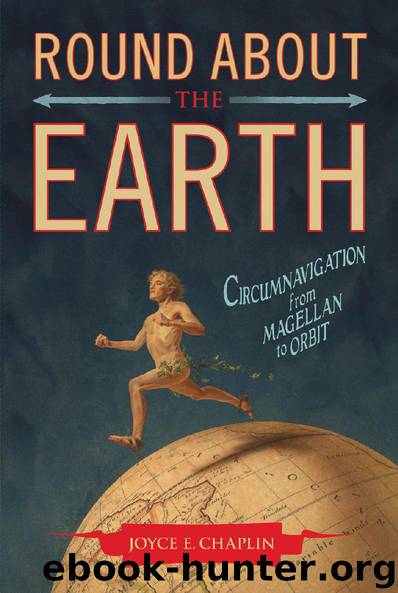Round About the Earth by Joyce E. Chaplin

Author:Joyce E. Chaplin
Language: eng
Format: epub
Publisher: Simon & Schuster
Greenwich best,
Longitude west.
It only works if you already know how to navigate. Eventually, London did. 41
He praised himself for knowing more about the planet than Uncle Roscoe anyway. The old fellow followed the teachings of Cyrus R. Teed, who spread the faith that the Earth was hollow. It was an old idea, though Teed embellished it with beliefs about immortality and free love, which gained him notoriety and acolytes. “Though we shall sail on the one boat, the Snark,” London marvels, “Roscoe will journey around the world on the inside, while I shall journey around on the outside.” As with Slocum confronting the Boer Flat Earthers, London put himself firmly on the side of modernity, as if stunt circumnavigators were continuing a kind of scientific investigation of the planet. 42
So many illnesses plagued the crew, however, that London, confident that suffering could be recycled as journalism, joked he would someday write a book called “Around the World on the Hospital Ship Snark.” In the tropical Pacific, enchanting at a distance, the heat and insects were torments. Malaria and other fevers burned the gumption from everyone. The smallest cut, scrape, or scratch became infected. The yacht’s animals died off from various accidents except for a terrier, which could only move by hopping on its two unsprained paws. The resident cockroaches grew and swarmed and gnawed the finger- and toenails of sleepers. Worst of all, the skin on London’s hands swelled and thickened until he could no longer grasp a rope or a pen. (His dermatological malady remains a mystery; it may have resulted from an epic sunburn in Hawai’i, where London learned to surf.) At Australia, in December 1908, he called it quits. After a year convalescing, he and Charmian sold the Snark and went home. In 1911, he would publish The Cruise of the Snark, to mixed reviews. “It is a pity that the joyfulness of the voyage is not communicated to the reader,” complained the reviewer from the Nation, who somehow missed that the voyage was a failure, a failed circumnavigation. 43
Harry A. Franck did make it around the world. His original plan was to do it “without money, without weapons, and without carrying baggage or supplies.” He modified the plan by taking a Kodak and $104. After arranging to sell dispatches to three magazines, he set out to prove that “random wandering” could yield as much edifying experience of the world as any “personally conducted tour.” 44
It was a beautiful idea, though ugly in execution. Franck intended, like Anderson, to work his way across oceans. By tending and bunking with cattle, he paid only £5 to cross the Atlantic. But once in Europe, he could not find work. An economic slump depressed demand for labor and Franck lacked Anderson’s useful skill set. He became a vagabond traveler, dressing in old clothes and tramping rather than paying train fare. In Germany, he broke down and purchased a fourth-class train ticket, jealous of the soldiers (and dogs) that cost less. In Europe, he accepted food from charitable establishments.
Download
This site does not store any files on its server. We only index and link to content provided by other sites. Please contact the content providers to delete copyright contents if any and email us, we'll remove relevant links or contents immediately.
| Historic | Information Systems |
| Regional |
Man-made Catastrophes and Risk Information Concealment by Dmitry Chernov & Didier Sornette(5921)
The Revenge of Geography: What the Map Tells Us About Coming Conflicts and the Battle Against Fate by Kaplan Robert D(4034)
Zero Waste Home by Bea Johnson(3777)
COSMOS by Carl Sagan(3554)
Good by S. Walden(3485)
In a Sunburned Country by Bill Bryson(3481)
The Fate of Rome: Climate, Disease, and the End of an Empire (The Princeton History of the Ancient World) by Kyle Harper(3003)
A Wilder Time by William E. Glassley(2818)
Camino Island by John Grisham(2762)
The Ogre by Doug Scott(2631)
Organic Mushroom Farming and Mycoremediation by Tradd Cotter(2626)
Human Dynamics Research in Smart and Connected Communities by Shih-Lung Shaw & Daniel Sui(2465)
Energy Myths and Realities by Vaclav Smil(2438)
The Traveler's Gift by Andy Andrews(2409)
9781803241661-PYTHON FOR ARCGIS PRO by Unknown(2321)
Inside the Middle East by Avi Melamed(2305)
Birds of New Guinea by Pratt Thane K.; Beehler Bruce M.; Anderton John C(2223)
A History of Warfare by John Keegan(2185)
Ultimate Navigation Manual by Lyle Brotherton(2129)
